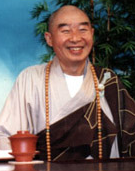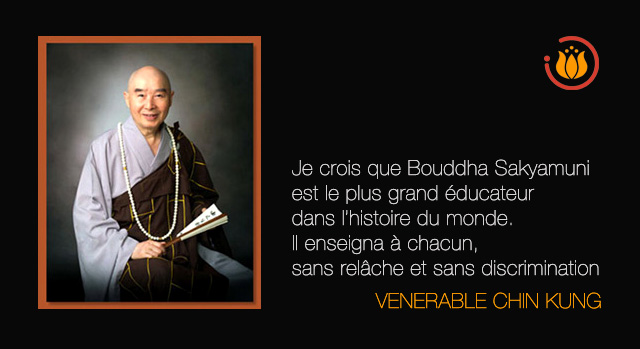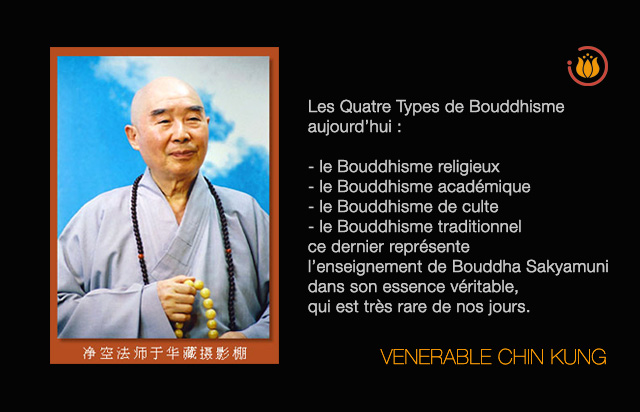 BUDDHISM AS AN EDUCATION
BUDDHISM AS AN EDUCATION
With Ven. Master Chin Kung
The Core of the Buddha’s Teaching
The Buddha’s teaching contains three major points: discipline, meditation and wisdom. Wisdom is the goal and deep meditation or concentration is the crucial process toward achieving wisdom. Discipline through observing the precepts, is the method that helps one to achieve deep meditation; wisdom will then be realized naturally. Buddha’s entire teachings as conveyed in the sutras never really depart from these three points. Buddhism encompasses the entire collection of works by Buddha Shakyamuni and is called the Tripitaka. This can be classified into three categories: sutra, vinaya (precepts or rules), and sastra (commentaries) which emphasize meditation, discipline, and wisdom respectively.

The Buddhist Educational Organization in China
Buddhist education is based on filial piety, as is the Chinese culture. Prior to the introduction of Buddhism to China, filial piety was the pillar of society and was supported by the wise men of ancient China. When Buddhist monks from India came to China and started to discuss Buddhism with government officials, it was immediately apparent to everyone that Buddhism shared numerous similarities with the indigenous Confucian traditions. Consequently, the government embraced them and requested that the monks stay in China permanently.
The first two monks, who came to China, Moton and Chufarlan, were received by the “Hong-Lu-Si” which is equivalent to our present Foreign Ministry or State Department. “Si” was designated as a ministry of the government. The Chief of Hong-Lu-Si is equivalent to a foreign minister or Secretary of State. However, Hong-Lu-Si could only receive foreign guests temporarily. In order to allow them to stay permanently, the Emperor added another ministry, “Bai-Ma-Si,” to take charge of Buddhist education. Originally, the “Si” had nothing to do with a temple, but merely denoted a ministry of the imperial court, now it denotes a temple in contemporary Chinese. So, there were two ministries in charge of education. The “Li-Bu,” managed by the Prime Minister, was in charge of the traditional Confucian educational system. This organization served the same function until the early 1900’s. As the Emperor had given enormous support to the “Bai-Ma-Si,” Buddhist education rapidly spread throughout China.
In many instances, it had even far exceeded the efforts to educate people than the traditional education system of “Li-Bu.” Consequently, there may not have been a Confucian or Manfucian school in every village, but there was a “Si” everywhere. Again, the Buddhist “Si”, or temple, used to be an educational institution and did not perform religious ceremonies at all, unlike what often takes place in contemporary temples nowadays.
Another important mission for the original “Si” was sutra translation. The scale of the translation effort is hard to imagine today. During the seventh century, the famous monk Xuan-Tsuang had supervised six hundred scholars in sutra translation. Prior to this, a monk named Kumaraja had a translation team of about four hundred scholars. Therefore, the “Si” was a large governmental organization. Unfortunately, it was completely transformed into a place to deal with superstition and spirits around two hundred years ago. Its educational characteristics totally disappeared, which was truly regretful.

The Four Current Types of Buddhism
Today, there are four types of Buddhism being practiced. First, there is the religious Buddhism, which can be witnessed in temples throughout Taiwan. However, this does not represent the real Buddhism. Second, there is the academic Buddhism being taught in many universities today, where we see Buddhism being treated purely as philosophy, an academic pursuit, especially in Japan. This is not exactly Buddha’s education either. Third, and the most unfortunate of all, is the total degeneration of Buddhism into a cult. This third type of Buddhism is much more damaging to the public than the first two types. Finally, there is the traditional Buddhism, the teachings of Buddha Shakyamuni in its true essence, which is very rare in our day and age.
The Author’s Own Experience with Buddhism
When I was a young student in Nanjing, I did not believe in any religion. I went to church with some classmates to learn about Christianity. Although I tried to understand it, I could not find a way to accept it. My favorite religion at that time was Islam because its emphasis was on moral principles and ethics, and I thought that this was rare among religions. When I encountered Buddhism back then, the monks were not very convincing. Therefore, I could not accept Buddhism either and it was the one I resisted the most. I was too young at that time and had not met a true practitioner.
After I arrived in Taiwan, I heard of Professor Dong-Mei Fang, who was then a famous philosopher and a professor at the National Taiwan University. Having become an admirer of his, I wrote him a letter asking about taking a class from him at the university. Professor Fang was only in his forties at that time. He invited me to his house and told me, “Nowadays in school, professors do not act like professors, and students do not act like students either. If you come to the university and expect to learn something, you will be sorely disappointed.” When I heard this, I was pretty upset since he had basically poured cold water over my plans. Finally, he told me: “Well, why don’t you come to my house every Sunday, and I will give you personal instruction for two hours.”
I could not believe that he was so compassionate towards me. I learned about philosophies at Professor Fang’s small table in his little living room, one on one. This was extremely precious to me. He introduced the philosophies of the West, China, India and finally Buddhism. He taught me that Buddhism is the pinnacle of the world’s philosophy and that it provides the greatest enjoyment for humanity. What he told me was fascinating and soon I realized that Buddhism contained something magnificent. I started to visit the temples in Taipei. However, the monks I met in those temples just could not clearly explain Buddhism to an intellectual skeptic like me. However, the monks are much better in teaching Buddhism today. Then I set my first sight on Shan-Dao-Si, which was a large temple in Taipei with a vast collection of sutras. During that period of time, the wide publication and circulation of Buddhist books was very rare.
The monks at Shan-Dao-Si were extremely kind to me as they allowed me to borrow many of the precious and rare sutras. This was a great help to me.
Soon after I started to learn Buddhism seriously, I was fortunate to meet Master Zhang-Jia. He was a well-accomplished Esoteric practitioner who taught and guided me in my study and practice. Just like Mr. Fang, he taught me two hours every week for three years until he passed away. I then went to Taizhong to follow Mr. Bing-Nan Lee and started studying and practicing with him.
Buddhism is a special kind of knowledge; it is not a religion. In order to derive true benefit from it, we have to understand it’s true nature. I have the utmost respect for Buddhism and I believe Buddha Shakyamuni to be the foremost educator in the history of the world. He was just like Confucius in that he taught everyone tirelessly and without discrimination.
Dharma Talks
By Vén. Chin Kung
Source : www.buddhanet.net




